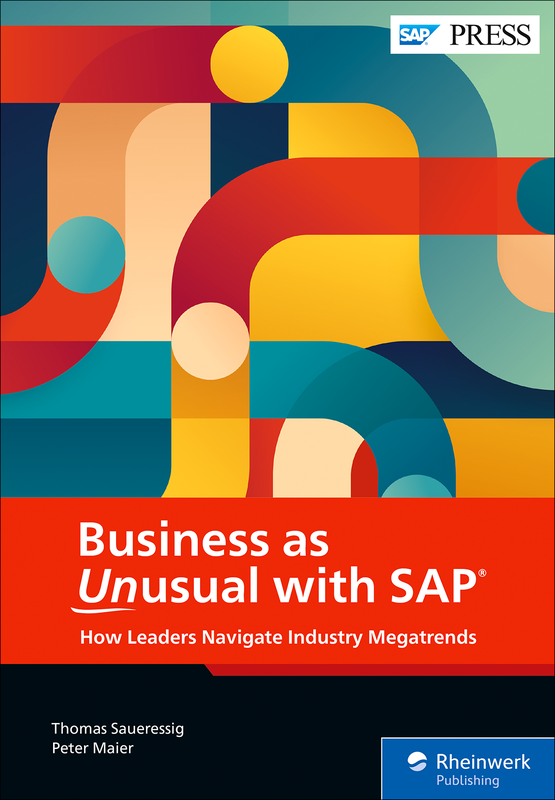
With a new book on the market, Business as UNusual with SAP, we have been looking forward to talking with Vinnie Mirchandani and his two senior VP’s at SAP about the megatrends they’re seeing powerfully ripple across the industry.
As Co-Author and SVP of Strategic Customer Engagements at SAP, Peter Maier, was great to speak with to elaborate on how megatrends are changing competitive playing fields and shaping best business practices.
M.R. Rangaswami: What was the motivation for you and your co-author, Thomas Saueressig, to write the book, Business as UNusual with SAP?

Peter Maier: In our customer conversations Thomas and I experience every day how megatrends are driving the business and technology agenda of our customers. We found it worthwhile to share their voice and perspective how leaders successfully navigate industry megatrends using the capabilities of our intelligent suite and our intelligent technologies.
There are a few simple but deep principles that drive SAP’s product and innovation strategy for our customers in their industries: we focus on our customers’ core business, because that’s where they drive revenue, competitive differentiation and strategic transformation of business models and business operations.
Then we look at end-to-end processes that run along value chains and across industry and company boundaries (that’s why digital business networks are so important). And we use a business filter when we look at new digital technologies: which have the potential to transform our customers’ business?
Artificial intelligence is a great example here, we believe there is huge business potential – but realizing this potential requires integrated end-to-end industry processes. So each megatrend can transform the business of our customers in their industries – and digital technologies are key enablers.
M.R. In your opinion, what makes this period of time “unusual”?
Peter: All consultants have been claiming for decades that the ongoing change requires customers to adjust their strategies and operations. However, the last three years have shown us how fundamentally and quickly our world can change and how important the ability to rapidly adapt to change has become. Multi-year corporate programs have been compressed into quarters, months, and weeks. Fundamental beliefs have gone out of the window. And we perceive a new open-mindedness of many leaders to try new things – to embrace the idea to run a “business as unusual”. So we think it makes sense to use this momentum and start customer engagements to discuss how megatrends can inspire new ways of doing new things.
Many people feel threatened by change. If you look into the root cause for this reaction, you’ll find that change is stressful if it outpaces your ability to adjust or even take advantage of it. This is a very good reason to build and run an organization so that it can easily (or at least better than their peers) cope with disruptive change. And this change comes from all directions, just look at the drivers like generative AI, sustainability, virtual reality, metaverse, geopolitical conflicts, or pandemics. “Prepping” for all eventualities is certainly not the answer, but building and running an intelligent, sustainable, resilient, and agile enterprise certainly is. And many companies and institutions look at SAP to find solutions for this transformation.
M.R. What are the most opportunistic and problematic trends that the book covers?
Peter: We believe that every single megatrend we are discussing holds threats and promises, depending on the reader’s attitude to running a “business as unusual.” Moving from selling products to providing and monetizing the outcome of using the product (“Everything as a service”) can be viewed as a problem for a business – or it can be treated as a great opportunity to create and expand new revenue streams, develop new business models, and establish fresh customer relationships.
Moving to a “circular economy” drives change in product design, supply chain, procurement practices, and product-end-of-life management in many industries. Whether this change is a reason for optimism or pessimism depends on whether this change is viewed as an opportunity or threat. And you will find the same duality in every single megatrend.
Over the course of our research and the discussions with customers, partners, and SAP experts the opportunity/threat balance clearly shifted from seeing problems and challenges to appreciating the potential for innovation and new business relationships. And of course, we are very happy and pleased that our SAP solutions will play key roles in tackling the challenges and capturing the promised value from transforming business processes and business models.
There are many digital technology trends – most prominently artificial intelligence – which we don’t feature in Business as UNusual with SAP as megatrends.
Business as UNusual with SAP focuses on business megatrends and how they shape and change competitive playing fields and best business practices, or how they transform end-to-end business processes along value chains and across industry boundaries.
Technology has always influenced, accelerated, and sometimes triggered business megatrends, and you will find that digital and other technologies and their impact are discussed in the context of each megatrend, from Lifelong Health to New Customer Pathways and from Integrated Mobility to the Future of Capital and Risk.
M.R. Rangaswami is the Co-Founder of Sandhill.com
